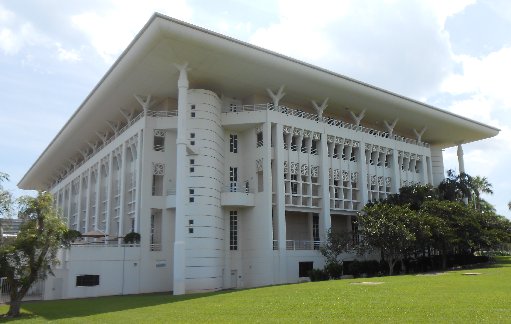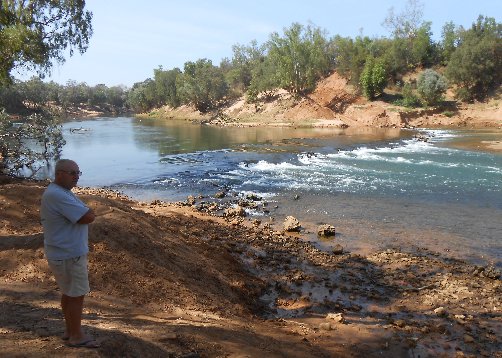24th August, 2012
Well the journey from Litchfield National Park to the outskirts of Darwin Howard Springs Caravan Park about 25 kms south of Darwin as it is in a quiet area away from the International Airport where most of the other Darwin Howard Springs now really an outer suburb of Darwin
 |
| It's like standing in fish soup ... |
It’s still a thrill to watch as the bevy of mullet, catfish and milkfish mill around to snatch a piece of bread from anyone and everyone.
 |
| I wonder if anyone would notice if I threw in a fishing line? |
Robyn takes a walk down the ramp for a closer look and gets to pat some very slimy mullet as they swim over each other to get their treat.
 |
| Here fishy, here fishy ..... |
There are other fish of course such as the batfish, barramundi, puffer fish, small sharks and stingrays but they are very much outnumbered by the greedy mullet. The daily fish feeding has been taking place since the 1960’s and is a Darwin
 |
| If that was a real mudcrab there's no way you'd be holding those claws! |
We drive into the heart of the city and put Mitzi in a car parking station for the day. As it is not a week day the parking is free. Wow! Try and do that in any other Australian city. Just outside the Information Centre is an amphibious duck which is just waiting for two intrepid explorers like us.
 |
| Jemima Duck |
We hop on board Jemima Duck for a Splash and Dash Tour. Our starting point is at the end of the Smith Street Mall (which wasn’t a mall twenty five years ago)
 |
| Smith Street Mall |
and down Mitchell Street
 |
| Darwin streetscape |
We drive past the Casino and Mindil Markets to Fannie Bay
 |
| Here we go - into the water! |
Then we sit back
 |
| Wok is enjoying his cruise on the harbour |
and enjoy the view of Darwin
 |
| View of Mindil Beach and the Casino |
There are lots of apartment complexes along the beaches and it is amazing to see the growth that has taken place.
 |
| Apartments and high rise in Darwin |
At Emery Point Lighthouse we turn around and head back to the boat ramp.
 |
| Emery Point - Lighthouse with World War II gun emplacements below |
We haven’t seen many denizens of the deep but each year approximately 300 saltwater crocs that are deemed to be of a size that is dangerous are captured and relocated. Those are the ones they see of course. And then there are the deadly jellyfish (two types), sharks, stingrays, stonefish and sea snakes. Is it any wonder that although the beaches have people sunbaking there is no-one actually in the water. By 1pm we are back in the city and take a walk along the mall and find a place to have some lunch. You know Subways are the same the world over! With our tummies full we take a walk along the esplanade past the impressive looking Parliament House built in 1994.
 |
| Parliament House |
Not far away are the remains of the Old Town Hall
 |
| The ruins of the Old Town Hall |
Built in 1883 the stone building survived two world wars but could not withstand the destructive winds of Cyclone Tracy which unleashed its fury on Christmas Eve 1974. By Christmas Day most of Darwin Australia Old Town Hall
 |
| Darwin Anglican Church |
The old stone porch of the church was all that was left standing after Cyclone Tracy hit. The new church incorporates the old stone porch into its design. It is quite an impressive piece of architecture. We stroll down to the waterfront and take a walk through the World War II Oil Storage Tunnels.
 |
| Entrance to the oil storage tunnels |
After the Japanese bombed Darwin
 |
| No 5 Oil Storage Tank |
As we walk down the long steel lined tunnel we stop to look at photo displays along the wall. Darwin Darwin Northern Territory
 |
| Darwin's Waterfront Precinct |
From our vantage point above the waterfront we could see the new Convention Centre and wave pool where lots of people were cooling off in the man made surf.
 |
| Convention Centre with Wave Pool on the left |
That was enough for us. We made a beeline for Mitzi and headed back to the campground where we quickly jumped in the pool to cool off. Finally the sun went down and things cooled down. Sunday was washing day – meaning clothes, car and van. Then after lunch we paid a visit to the Museum and Art Gallery Darwin Darwin


































